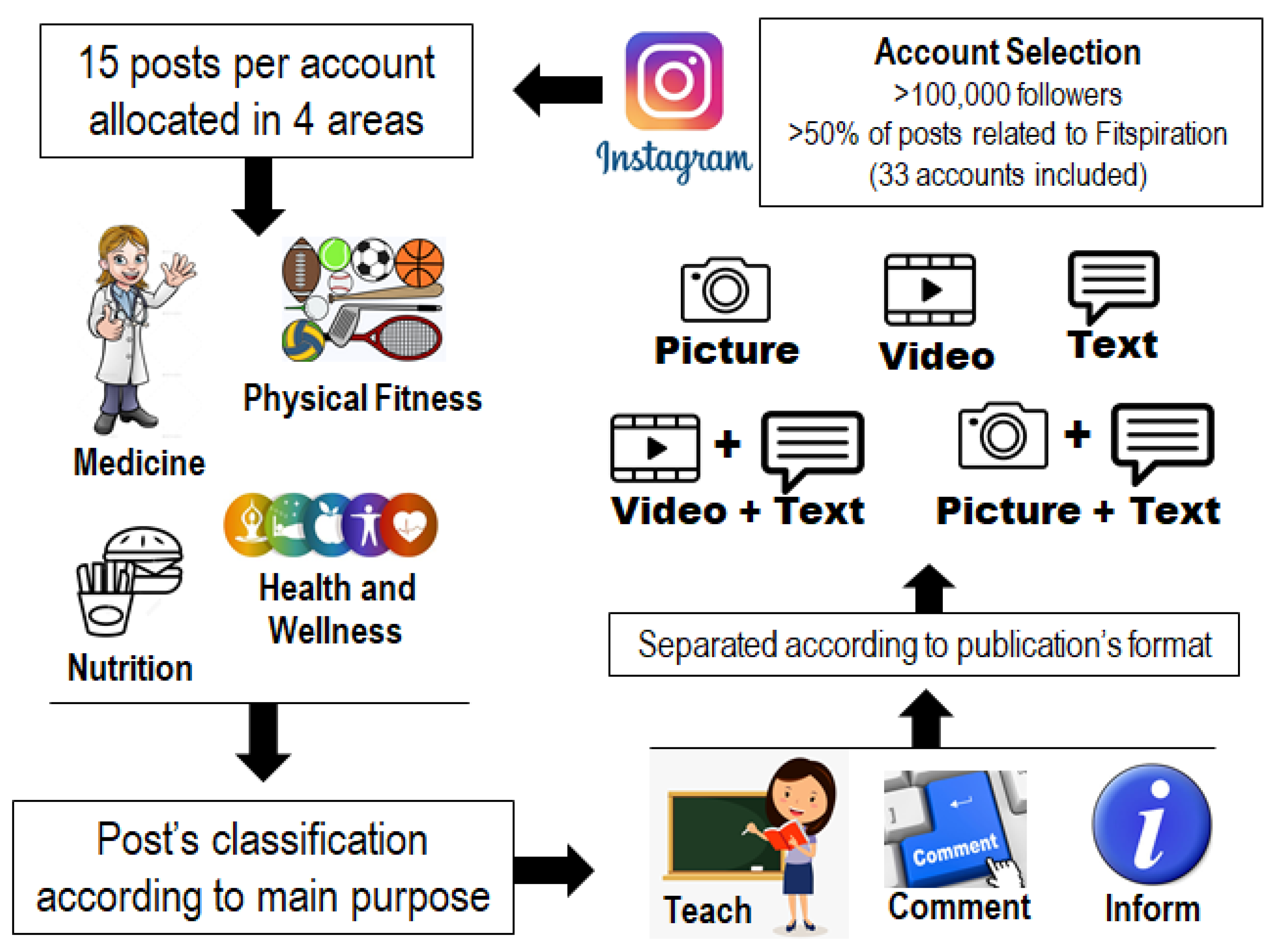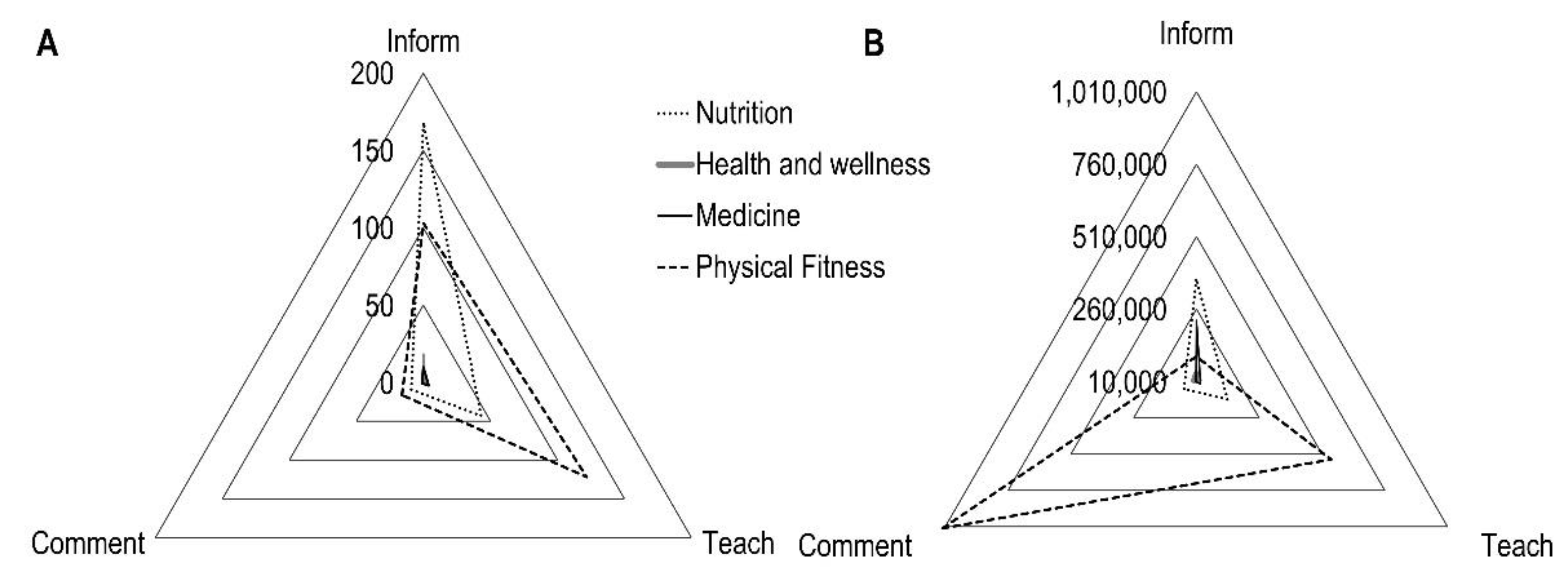Is Social Media Spreading Misinformation on Exercise and Health in Brazil?
Abstract
1. Introduction
2. Materials and Methods
2.1. Ethics Approval and Consent to Participate
2.2. Account Selection Criteria
2.3. Technical Evaluation of Influencers
2.4. Post’s Inclusion and Classification
2.5. Quality Criteria Assessment
2.6. Statistical Analysis
3. Results
4. Discussion
5. Conclusions
Author Contributions
Funding
Institutional Review Board Statement
Informed Consent Statement
Data Availability Statement
Conflicts of Interest
References
- Bik, H.M.; Goldstein, M.C. An introduction to social media for scientists. PLoS Biol. 2013, 11, e1001535. [Google Scholar] [CrossRef] [PubMed]
- Edney, S.; Bogomolova, S.; Ryan, J.; Olds, T.; Sanders, I.; Maher, C. Creating Engaging Health Promotion Campaigns on Social Media: Observations and Lessons From Fitbit and Garmin. J. Med. Internet Res. 2018, 20, e10911. [Google Scholar] [CrossRef] [PubMed]
- Santarossa, S.; Woodruff, S.J. #LancerHealth: Using Twitter and Instagram as a tool in a campus wide health promotion initiative. J. Public Health Res. 2018, 7, 1166. [Google Scholar] [PubMed]
- Hillman, T.; Sherbino, J. Social media in medical education: A new pedagogical paradigm? Postgrad. Med. J. 2015, 91, 544–545. [Google Scholar] [CrossRef] [PubMed][Green Version]
- Lin, T.M.Y.; Lu, K.Y.; Wu, J.J. The effects of visual information in eWOM communication. J. Res. Interact. Mark. 2012, 6, 7–26. [Google Scholar] [CrossRef]
- Tiggemann, M.; Zaccardo, M. Strong is the new skinny: A content analysis of #fitspiration images on Instagram. J. Health Psychol. 2018, 23, 1003–1011. [Google Scholar] [PubMed]
- Carrotte, E.R.; Prichard, I.; Lim, M.S. Fitspiration on Social Media: A Content Analysis of Gendered Images. J. Med. Internet Res. 2017, 19, e95. [Google Scholar] [CrossRef] [PubMed]
- Pilgrim, K.; Bohnet-Joschko, S. Selling health and happiness how influencers communicate on Instagram about dieting and exercise: Mixed methods research. BMC Public Health 2019, 19, 1054. [Google Scholar] [CrossRef] [PubMed]
- Pulido, C.M.; Ruiz-Eugenio, L.; Redondo-Sama, G.; Villarejo-Carballido, B. A New Application of Social Impact in Social Media for Overcoming Fake News in Health. Int J. Env. Res. Public Health 2020, 17, 2430. [Google Scholar] [CrossRef] [PubMed]
- Lin, M.; Thoma, B.; Trueger, N.S.; Ankel, F.; Sherbino, J.; Chan, T. Quality indicators for blogs and podcasts used in medical education: Modified Delphi consensus recommendations by an international cohort of health professions educators. Postgrad Med. J. 2015, 91, 546–550. [Google Scholar] [CrossRef] [PubMed]
- In science we trust. Nat. Med. 2001, 7, 871. Available online: https://www.nature.com/articles/nm0801_871.pdf (accessed on 25 May 2021). [CrossRef] [PubMed]
- Ten Have, H.; Gordijn, B. Trust in healthcare and science. Med. Health Care Philos 2018, 21, 157–158. [Google Scholar] [CrossRef] [PubMed]
- Metzger, M.J.; Flanagin, A.J. Credibility and trust of information in online environments: The use of cognitive heuristics. J. Pragmat. 2013, 59, 210–220. [Google Scholar] [CrossRef]
- Cook, J.; Lewandowsky, S.; Ecker, U.K.H. Neutralizing misinformation through inoculation: Exposing misleading argumentation techniques reduces their influence. PLoS ONE 2017, 12, e0175799. [Google Scholar] [CrossRef] [PubMed]
- Statler, T.; Brown, V. Facility Policies, Procedures, and Legal Issues. In Essentials of Strength Training and Conditioning, 4th ed.; Haff, G.G., Triplett, N.T., Eds.; Human Kinetics: Champaign, IL, USA, 2016; Volume 4, pp. 641–656. [Google Scholar]
- Leskin, P. Influencers are Fighting for Attention as Instagram Tests Removing Likes from its Platform: There’s no Audience Applause at the End of a Performance. Available online: https://www.businessinsider.com/instagram-influencers-removing-likes-impact-2019-9 (accessed on 9 April 2020).


| Quality Criteria | Explanation | Scoring |
|---|---|---|
| (1) Is the author academically/professionally qualified to provide information on the mentioned topic? | Account’s administrator must have a compatible academic or professional qualification to be qualified to make recommendations on the mentioned topic (e.g., nutritionists cannot prescribe exercise). | 0 points for without professional qualification 1 point for Bachelor of Science 2 points for Specialist 3 points for Master of Science 4 points for Doctor of Science/PhD |
| (2) Does the author cite any source of information? | Acknowledgment of the source of the information used in the post, such as a scientific study or a book, is preferable for transparency and reliability. | 1 point if yes or 0 if not. |
| (3) Are the post’s statements in agreement with the cited references? 1 | (1) If a reference is cited, the post must be aligned with its source. Presenting an irrelevant reference should be a problem. (2) If a recommendation is posted, it cannot directly contradict the source (e.g., exercise parameters must be recommended in accordance with the cited reference). (3) If a recommendation is not applicable, the conclusions presented in the post must be based on the cited reference. | 1 point only if all three concerns were clearly fulfilled. |
| (4) Are the post’s guidance supported by any scientific source, even if no reference was cited at all? | The recommendation must be methodologically reasonable/feasible. (1) Even without a scientific source, the recommendation/statement/suggestion cannot be deleterious to health (e.g., advocate the use of steroids). (2) The information needs to be in line with scientifically proven and available evidence on the topic. | 1 point only if all two concerns were clearly fulfilled. |
| Posts (n) | Likes/Post | |
|---|---|---|
| Picture | 196 | 6392.8 |
| Video | 211 | 12,042.7 |
| Text | 2 | 13,314 |
| Picture/Text | 84 | 4136.1 |
| Video/Text | 2 | 2367.5 |
| Academic/Professional Qualification | Quantification | B.Sc. | Specialist | M.Sc | D.Sc/Ph.D |
|---|---|---|---|---|---|
| Medical doctor | 4 | - | 2 | 2 | - |
| Nutritionist | 10 | 6 | 1 | 1 | 2 |
| Pharmacist | 1 | - | - | - | 1 |
| Sport Sciences/Kinesiology | 9 | 5 | 1 | 1 | 2 |
| Physiotherapist | 1 | - | - | - | 1 |
| Without professional qualification | 8 | - | - | - | - |
| QC1 (Account) | QC2 (Post) | QC3 (Post) | QC4 (Post) | Quality-Ratio Score (Account + Post) | ||||
|---|---|---|---|---|---|---|---|---|
| Account (n) | Score (median) | Posts (n) | Score (reached) | Posts (n) | Score (reached) | Posts (n) | Score (reached) | % (Mean ± SD) |
| 33 | 1 | 495 | 95 | 495 | 13 | 495 | 217 | 38.79 ± 25.43 |
| Number of Likes | Academic/Professional Qualification | Quality-Ratio Score | |
|---|---|---|---|
| Number of followers | 0.606 * | −0.450 * | −0.178 |
| Number of likes | - | −0.108 | −0.187 |
| Academic/Professional qualification of the influencers | - | - | 0.313 |
Publisher’s Note: MDPI stays neutral with regard to jurisdictional claims in published maps and institutional affiliations. |
© 2021 by the authors. Licensee MDPI, Basel, Switzerland. This article is an open access article distributed under the terms and conditions of the Creative Commons Attribution (CC BY) license (https://creativecommons.org/licenses/by/4.0/).
Share and Cite
Marocolo, M.; Meireles, A.; de Souza, H.L.R.; Mota, G.R.; Oranchuk, D.J.; Arriel, R.A.; Leite, L.H.R. Is Social Media Spreading Misinformation on Exercise and Health in Brazil? Int. J. Environ. Res. Public Health 2021, 18, 11914. https://doi.org/10.3390/ijerph182211914
Marocolo M, Meireles A, de Souza HLR, Mota GR, Oranchuk DJ, Arriel RA, Leite LHR. Is Social Media Spreading Misinformation on Exercise and Health in Brazil? International Journal of Environmental Research and Public Health. 2021; 18(22):11914. https://doi.org/10.3390/ijerph182211914
Chicago/Turabian StyleMarocolo, Moacir, Anderson Meireles, Hiago Leandro Rodrigues de Souza, Gustavo Ribeiro Mota, Dustin Jay Oranchuk, Rhaí André Arriel, and Laura Hora Rios Leite. 2021. "Is Social Media Spreading Misinformation on Exercise and Health in Brazil?" International Journal of Environmental Research and Public Health 18, no. 22: 11914. https://doi.org/10.3390/ijerph182211914
APA StyleMarocolo, M., Meireles, A., de Souza, H. L. R., Mota, G. R., Oranchuk, D. J., Arriel, R. A., & Leite, L. H. R. (2021). Is Social Media Spreading Misinformation on Exercise and Health in Brazil? International Journal of Environmental Research and Public Health, 18(22), 11914. https://doi.org/10.3390/ijerph182211914







